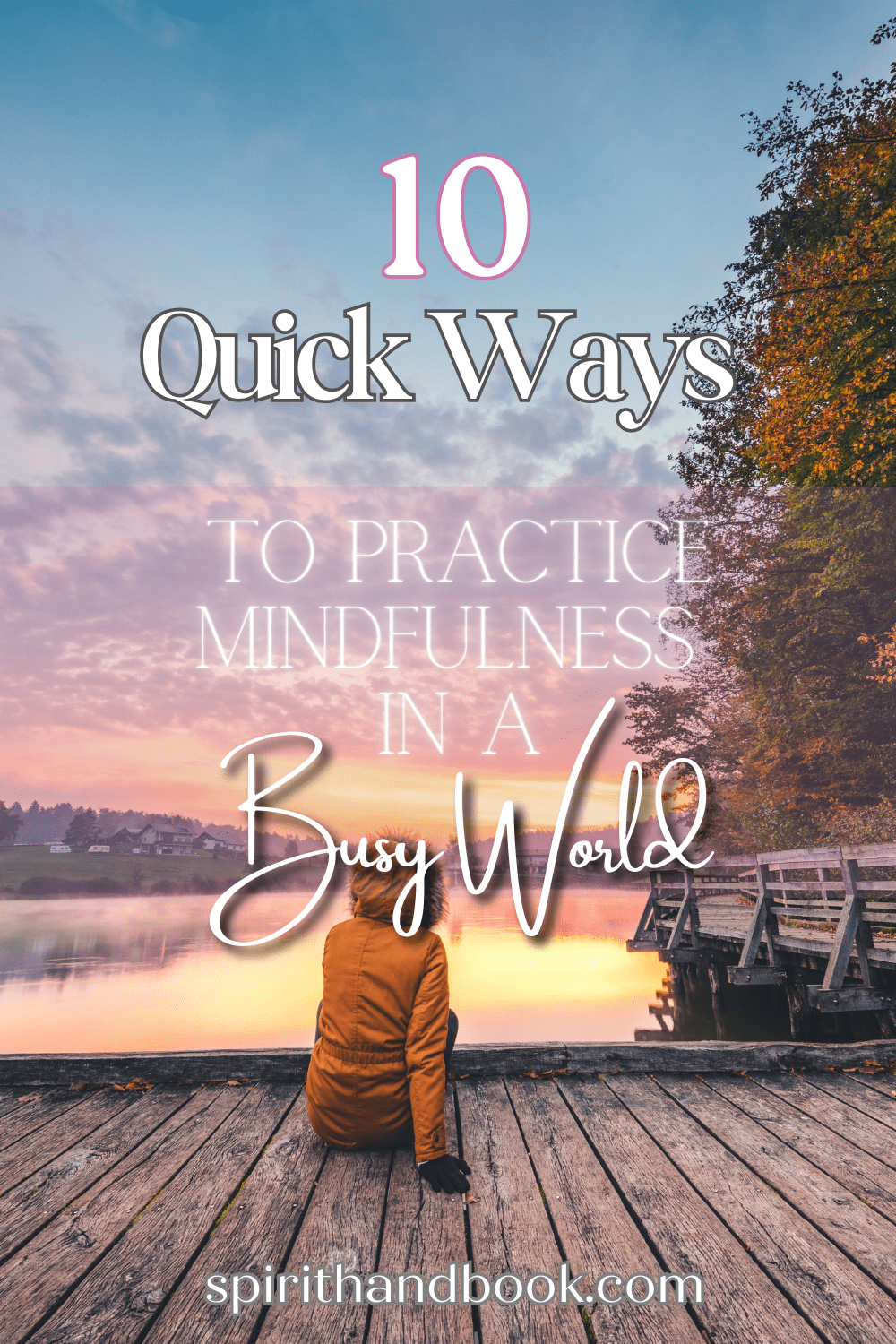Our lives are often packed to the brim with things to do, isn’t it?
Work deadlines, family responsibilities, chores, errands – it’s easy for our days to
become consumed by busyness.
While being productive isn’t a bad thing, running from one task to the next on autopilot can be draining. We lose touch with the present moment.
That’s where mindfulness comes in! Mindfulness helps us tune into the here and now, rather than getting tangled up in thoughts about the past or future.
In this post, we’ll dive into 10 simple yet impactful ways to practice mindfulness and
create space for it in your busy life.
Whether you have 5 spare minutes or half an hour, there are quick exercises you
can integrate into your day to stop, breathe, and reconnect with the present.
Carving out small pockets for mindfulness can make a big difference. Get ready to learn practical tips to become more mindful, even when life feels hectic.
What Is Mindfulness And Its Importance?
In essence, mindfulness means being present and engaged with the now instead of being caught up in distractions or thoughts about the past or future.
It’s about bringing an attitude of openness, curiosity, and nonjudgement to your moment-to-moment experience.
Being mindful is the opposite of rushing on autopilot. It’s intentionally tuning into your thoughts, feelings, bodily sensations, and surroundings with gentleness and care.
Cultivating mindfulness offers many benefits. It can lower stress, improve focus,
boost mood and resilience, deepen connections with others, and promote overall well-being.
Even just taking a few minutes to stop and breathe mindfully can calm and center you.
10 Quick Ways To Practice Mindfulness In A Busy World
Mindful Breathing.
One of the easiest ways to practice mindfulness is to focus your attention on your
breath. Mindful breathing anchors you in the present moment and helps calm your mind and body.
Here’s how to practice it:
- Find a comfortable seated position and close your eyes if you like.
- Bring your awareness to the physical sensation of breathing.
- Pay attention to the air moving in and out of your nose or mouth, the rising and falling of your chest.
- Don’t try to control your breath. Just observe.
Your mind will wander, and that’s okay! When it does, gently return your focus to
your breath.
Even taking a minute or two to tune into your breathing can be centering and help provide clarity. Over time and with practice, mindful breathing gets easier.
The good news is that your breath is always there for you. No need for any fancy tools or tech. Simple mindful breathing exercises can lower anxiety, reduce blood pressure, and relieve stress. Give it a try next time you need calm in the chaos.
Mindful Eating.
“Mindful eating” helps practice mindfulness by bringing awareness to one of our most common daily activities – food!
It involves purposefully paying full attention to eating and drinking rather than mindlessly rushing through a meal.
- Start by noticing the colors, textures, smells, and even sounds of your food.
- Slow down and chew thoroughly, putting your utensil down between bites. Savor each flavorful nuance.
- Notice how the food feels in your mouth and how satisfying it is to really taste your food.
Pay attention when you start to feel full and stop eating before you feel stuffed. Eat at a table without distractions when you can. Observe how eating certain foods impacts your energy and mood.
Approaching meals mindfully helps you tune in to signals of hunger and fullness. It can improve digestion, portion control, and enjoyment of food. Bringing mindfulness to eating helps transform an everyday activity into an opportunity to reduce stress and nourish yourself.
Body Scan Meditation.
The body scan is a mindfulness meditation that tunes you into physical sensations throughout your body.
To begin. Get into a comfortable position lying on your back or sitting. Close your eyes if you like. Bring attention to your breathing for a few moments.
Then, systematically scan through different parts of your body from head to toe, noticing how each feels. Pay attention to any areas of tightness, pain, relaxation, pulsing, warmth, or coolness.
When your mind wanders, gently return your focus to the body. Don’t judge any sensations as good or bad – just observe.
A body scan meditation lasts 10 minutes or longer. Practicing it cultivates greater body awareness and reduces tension. It can also help relax you before bed.
The body is always with us in the present moment. Tuning into it through a body scan keeps you grounded and centered amidst life’s rush. Take some time to connect to your physical being through this powerful mindfulness practice.
Mindful Technology Usage.
Phones, computers, tablets – technology often demands much of our attention these days. We can easily lose hours mindlessly scrolling and reacting instead of intentionally choosing how to engage online.
Practicing mindfulness with technology means using devices with more conscious intention!
Before grabbing your phone, pause and ask yourself what you need from it at that moment – do you have a specific purpose, or are you reaching for it out of boredom or habit?
When using devices and apps, stay focused on your actual aim rather than getting sidetracked and overstimulated. Turn off distracting notifications when you need to concentrate. Notice how certain sites impact your mood.
Unplug and take tech-free breaks to give your mind respite. Be fully present for in-person connections without lapsing into “phone zombie” mode.
Applying mindfulness to the digital realm helps foster healthier relationships with our devices, keeping us centered in real life.
Cultivate Gratitude and Positivity.
It’s easy to get caught in a spiral of negativity when life feels stressful and busy.
Practicing gratitude helps counter those tendencies. Mindfully focusing on what we appreciate injects more positivity into each day.
Take a few moments in the morning or evening to reflect on people, experiences, and simple pleasures you feel grateful for. Keep a gratitude journal to maintain awareness of the good already present in your life.
Share expressions of thanks with loved ones. Savor your morning coffee or the
comfiness of your bed with intention and appreciation. Notice small delights throughout your day, like a sunny day or a friend’s smile.
Studies show that cultivating gratitude boosts happiness and reduces anxiety and depression. Positivity allows us to approach hardships from a place of strength rather than lack.
Make gratitude and positive thinking habits through daily mindfulness. Even when life feels chaotic, you’ll have a foundation of inner peace to stand on and reminders of what’s going right.
Mindfulness in Daily Activities.
Mindfulness isn’t restricted to formal meditation sessions – we can cultivate it through everyday activities too!
Brushing your teeth, washing dishes, folding laundry, and other routine tasks all provide chances to anchor yourself in the present.
Approach daily chores with full focus and care. Notice the sensations involved – the warmth of the water, the minty smell of toothpaste, and the texture of the dishes. Tune into the motions your body makes as you work.
If your mind wanders, gently return your attention to the activity at hand. Avoid going into autopilot mode where you rush through tasks without awareness. Find moments of micro mindfulness even in mundane errands like buying groceries or filling your car with gas.
Bringing mindful presence to your daily routine imbues simple actions with a sense of meaning and care. Regular activities become opportunities to practice living fully in each moment.
Create Mindful Spaces.
It’s easier to tap into a mindful mindset when you carve out spaces conducive to
it. Consider what elements help you feel calm, focused, and present.
Declutter your surroundings and live/work areas to promote clarity. Incorporate soothing
natural elements like houseplants, flowers, or even simple rocks. Use essential oils, candles, or soft lighting to cultivate a relaxed ambiance.
Listen to tranquil music or soothing nature sounds. Display inspirational quotes and artwork that uplifts you. Minimize clutter and distractions in your space.
You can even create a small dedicated mindfulness corner. Include an altar, meditation cushions, spiritual tomes, or any items that prompt greater awareness.
When you intentionally curate a harmonious environment, you’re reminded to breathe and reconnect with the present throughout your time there. Your external landscape impacts your inner terrain, so surround yourself with mindfulness triggers.
Mindful Time Management.
It’s easy to get overwhelmed when you have too much to do and not enough time.
Mindfulness can introduce calm productivity to your busy schedule.
Rather than anxiously rushing through your to-do list, pause and intentionally prioritize what requires your attention.
Focus on one task at a time. Schedule breaks to recharge. When you notice yourself feeling frazzled, take a few mindful breaths.
Avoid multitasking, which often means performing several tasks poorly. If you find
your mind wandering, gently return your focus to the current assignment. Eliminate unnecessary distractions and interruptions.
Working efficiently yet mindfully, you expend energy where it matters most. Tasks feel
manageable rather than monumental. You achieve more while lowering stress.
With practice, you can make mindfulness a habit even in busier times. Mindful time management keeps you present yet productive through the chaos.
Relationships and Mindfulness.
It’s easy to go through our relationships without truly connecting or communicating mindfully. But we can transform our bonds by cultivating awareness.
When speaking with loved ones, colleagues, and friends, be fully present. Don’t just pretend to listen while planning what to say next. Make eye contact and focus on understanding their perspective.
Express gratitude and affection to nurture your connections. Ask thoughtful questions to go deeper. Reflect before reacting to conflict; a mindful response is better than a knee-jerk one.
Remind yourself that even during disagreements, this person deserves compassion. See their humanity.
Schedule quality time together away from screens and distractions. Share in mindful activities like walking, cooking, or painting.
Mindfulness strengthens relationships by helping us engage wholeheartedly, express gratitude, and bring more empathy and patience to the people in our lives.
Mindfulness for Better Sleep.
Do you find yourself lying awake at night, unable to quiet your racing mind?
Practicing mindfulness can help you unwind both mentally and physically for restful sleep.
Try a body scan meditation in bed to relax tense muscles and focus your awareness on the present. Breathe deeply and slowly to calm your nervous system. Let any anxious thoughts pass by without judgment.
Write down your worries earlier in the evening to empty them from your mind. Make a list of things you’re grateful for today.
Notice any emotions keeping you up without suppressing them. Acknowledge them with care, then return your attention to your breath.
Limit stimulation from screens before bedtime, keep the bedroom dark and cool, and try calming aromatherapy. Set yourself up for sleep success.
Mindfulness releases the brakes that can keep our minds revved when we really need rest. By training your mind to stay anchored and relaxed in the present moment, you’ll drift off to sleep more smoothly.
Conclusion: 10 Quick Ways To Practice Mindfulness In A Busy World
Living mindfully is ongoing work rather than a destination. But with regular gentle practice, mindful moments become effortless habits.
Start small if needed, even 30 seconds of mindful breathing helps. Be patient and compassionate with yourself.
Remember that life happens in the current moment. Rushing through it causes unnecessary stress.
Choose presence – savor your coffee, feel the breeze, and engage fully with loved ones.
Unplug often.
Mindfulness won’t eliminate life’s pressures, but it helps you respond to them with more clarity, wisdom, and care for yourself and others. Keep cultivating it through daily exercises.
You have the power to create inner calm amidst outer chaos!
Guest Author – Varun Pahwa
Hi there! I am Varun Pahwa.
I’ve learned several lessons from some of my darkest life experiences. Join me at Uprisehigh.com where I share brilliant tips on self-improvement, relationships, life simplification, & a lot more. Share your stories and honor me with the opportunity to help you with your problems.
My readers support Spirithandbook. When you buy through links on my site, I may earn some coffee ☕ money (which I promise to drink while continuing to support your spiritual journey ✨).





